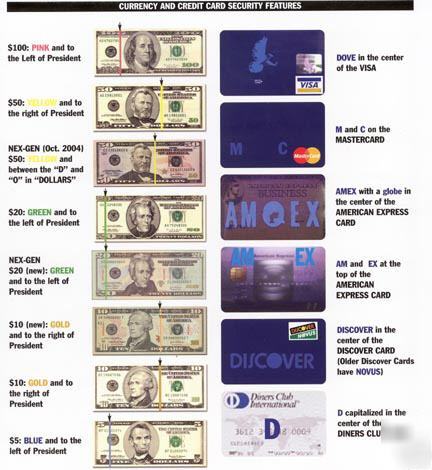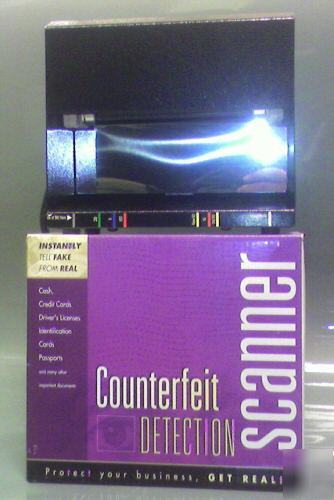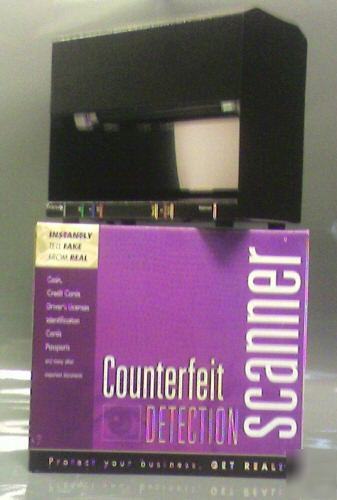Reduce Scrapping and Smelting, Promote Component Reuse > Engine Powered
> Gasoline Powered
> DuPage County
> New
> Counterfeit detection - fraud fighter uv-16
Counterfeit detection - fraud fighter uv-16
Designed for medium lit retail and point of sale locations, and featuring solid steel construction, the Fake-Finder Model UV-16 is the most powerful compact ultra-violet counterfeit detection equipment made. The unique UV tubes produce twice as much power.
The Modern Face of Counterfeiting
Throughout most of the 20th century, the techniques for counterfeiting U.S. currency remained unchanged. Using photographic plates, stencils, and offset printers, counterfeiting required the advanced skill-set of the professional counterfeiter, who over the years would perfect his craft in an attempt to overcome the security features of U.S. currency. Primary among these is the printing method of money itself, the "intaglio" process, where heavy presses force ink deep into the paper, to create the distinctive "raised" feel that is recognizable to anyone who has ever handled a Federal Reserve Note. Offset printing can only imperfectly re-create such an effect but, with care, the result is often good enough to pass.
Many additional security features, from intricate scrolling to the use of both green and black ink to the use of special paper, have typically presented challenges for all but the most determined counterfeiter. Some features of money are especially hard to reproduce, such as the fine red and blue fibers that are embedded in the paper, or specialty ultra-violet or infra-red fluorescent inks that are difficult to work with. Many counterfeiters omit these features altogether. For this reason, the Fake-Finder line of ultra-violet counterfeit scanners is such an effective method for counterfeit detection.
Today, counterfeiting requires a much smaller initial investment and, consequently, a smaller amount of product to make it profitable. A good color scanner, computer, and laser-jet printer, capable of producing passable-quality color copies, can be had for about $1,000.
This lower threshold not only allows someone to print counterfeit money secretly at home, but also frees them from the need to rely on others to launder large amounts of counterfeit bills. Thus, even though digitally reproduced counterfeits tend to be slightly lower in quality than offset notes, they are less likely to be seized and more likely to be passed into circulation. According the Counterfeit Division of the Secret Service, there has been a recent proliferation in digital counterfeiting by street gangs and links with the drug trade. The cumulative result has been an explosion in the number of counterfeiting operations, each producing a relatively small quantity of fake money, good enough to be passed at retail outlets. No longer able to rely on the seizure of large blocks of cash, the Secret Service has seen its domestic seizure rate fall steadily, from 70 percent in 1995, to 26 percent today. Accordingly, a growing number of counterfeits are being passed on to the public.
The best way to stop counterfeiters, of course, is to deter them before they have the chance to pass the bills to retail establishments. Anticipating the growing threat from desktop counterfeiting, U.S. currency was redesigned in 1996. On the redesigned bills (called "big-heads" by professional currency handlers), several new features make it more difficult to copy and easier to verify: most notably, a larger off-center portrait, the watermark portrait on the front and back of the bill, a security thread in the fiber of the bill which glows under UV light, additional micro printing, and color-shifting ink in the lower right-hand corner. Nonetheless, it was only a matter of months before the new bills started to be counterfeited, including many of the new security features. Yet, the redesign appears at least to have raised the bar, and the ultra-violet test has proven to be highly effective.
If people took the short amount of time to look at their money under UV light, almost all counterfeiting could be wiped out. Still, any effective scrutiny of currency for counterfeits by the general public remains uncommon. The predominant line of defense is banks, where tellers screen bills at the time of deposit, many of them using the Fake-Finder UV F-12 in combination with a training program outlined by the Secret Service. In cash processing at the Federal Reserve, sophisticated machinery and expert human eyes weed out the rest.
The computer revolution has marked a new chapter in the never-ending race between counterfeiters and the government. Already, scientists at Johns Hopkins University and elsewhere are investigating the possible role of holograms, plastics, and other materials that may be used to manufacture our money in the future. Still, no matter how sophisticated, there is no such thing as a "counterfeit-proof" bill.
Designed for medium lit retail and point of sale locations, and featuring solid steel construction, the Fraud Fighter Model UV-16 is the most powerful compact ultra-violet counterfeit detection equipment made. The unique UV tubes (patent pending) produce twice as much power as normally available.
* Dimensions - Length 6.5" (165 mm), Height 5" (143 mm), Width 3" (76 mm)
* Warranty - Lifetime limited warranty.
Strip Shows proper positioning of new UV security threads and watermarks on $5, $10, $20, $50, and $100 US currency.
BANKS , RESTAURANTS , TRADE SHOWS ,
RETAIL STORES , GUN SHOWS , CAR SHOWS
CHECK CASHING BUSINESSES AND JUST ABOUT
ANYWHERE THAT YOU NEED TO CHECK
TRAVELERS CHECKS ,PASSPORTS AND MUCH MORE


